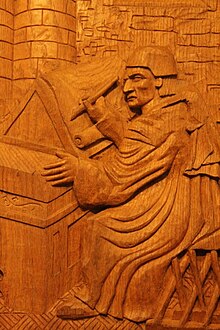John Barbour (poet)
John Barbour | |
|---|---|
 | |
| Born | c. 1320 |
| Died | 13 March 1395 (aged c. 75) |
| Nationality | Scottish |
| Occupation(s) | churchman and poet |
| Notable work | The Brus |

John Barbour (c.1320 – 13 March 1395) was a
Barbour was latterly Archdeacon of the
He died in 1395, probably in Aberdeen.
Life

John Barbour may have been born around 1320 if the record of his age in 1375 as 55 is correct. His birthplace is not known, though
Barbour's first appearance in the historical record comes in 1356 with promotion to the
After the death of David II in 1371, Barbour served in the royal court of Robert II in a number of capacities. It was during this time that he composed, The Brus, receiving for this in 1377 the gift of ten
The only biographical evidence for his closing years is his signature as a witness to sundry deeds in the "Register of Aberdeen" in 1392. According to the obit-book of
Works
The Brus


Barbour's purpose in the poem was partly historical and partly patriotic. He celebrates The Bruce (Robert I) and Douglas throughout as the flowers of Scottish
Barbour's style in the poem is vigorous, his line generally fluid and quick, and there are passages of high merit. The most quoted part is Book 1, lines 225-228:
A! fredome is a noble thing!
Fredome mayss man to haiff liking;
Fredome all solace to man giffis:
He levys at ess that frely levys!
Stewartis Oryginalle
One of Barbour's known lost works is The Stewartis Oryginalle which is described as having traced the genealogy of the Stewarts. The Stewart name replaced that of Bruce in the Scottish royal line when Robert II acceded to the throne after the death of David II, his uncle.
Robert II was Barbour's royal
Buik of Alexander
Attempts have been made to name Barbour as the author of the
Legends of the Saints
Another possible work was added to Barbour's canon with the discovery in the library of the
Legacy
As "father" of Scots poetry, Barbour holds a place in the Scotland's literary tradition similar to the position often given to Chaucer, his slightly later contemporary, vis à vis the vernacular tradition in England. If he truly was the author of the five or six long works in Scots which different witnesses ascribe to him, then he would have been one of the most voluminous writers of Early Scots, if not the most voluminous of all Scots poets. But his authorship of The Brus alone, both for its original employment of the chivalric genre, and as a tale of a struggle against tyranny,[2] secures his place as an important and innovative literary voice who broke new linguistic ground.
See also
References
- ^ The BruceCanongate Classics, 1999 edition. "Introduction", pp. 2–3
- The BruceCanongate Classics, 1999 edition. "Preface", p.vii
Further reading
- Barbour's Bruce, edited by Matthew P. McDiarmid and James A. C. Stevenson, 3 volumes. Edinburgh, Scottish Text Society, 1980–5.
- The Bruce: A Selection, edited by Alexander Kinghorn. Edinburgh, 1960. The Saltire Classics.
- Barbour, Johne (1375), "The Story of The Brus", in Innes, Cosmo (ed.), The Brus, Aberdeen: The Spalding Club (published 1856), retrieved 17 August 2008 - in Scots
- Barbour, Johne (1375), Skeat, Walter W. (ed.), The Bruce; or, The Book of the most excellent and noble prince, Robert de Broyss, King of Scots, London: Early English Text Society (published 1870), retrieved 17 August 2008 - in Scots with Modern English annotations
- Barbour, Johne (1375), Eyre-Todd, George (ed.), The Bruce, being the Metrical History of Robert The Bruce, King of Scots, London: Gowans & Gray Limited (published 1907), retrieved 17 August 2008 - a modern English translation
- John Barbour's The Bruce: A Free Translation in Verse by James Higgins. Bury St Edmunds, Abramis, 2013.
- Chambers, Robert; Thomson, Thomas Napier (1857). . A Biographical Dictionary of Eminent Scotsmen. Vol. 1. Glasgow: Blackie and Son. pp. 133–139 – via Wikisource.
- Titterton, James (31 December 2018). "Worthy, Wycht and Wys: Romance, Chivalry, and Chivalric Language in John Barbour's Bruce". Leeds Studies in English. 49: 101–120.
External links
 Works by or about John Barbour at Wikisource
Works by or about John Barbour at Wikisource- Works by John Barbour at Project Gutenberg
- Works by or about John Barbour at Internet Archive
